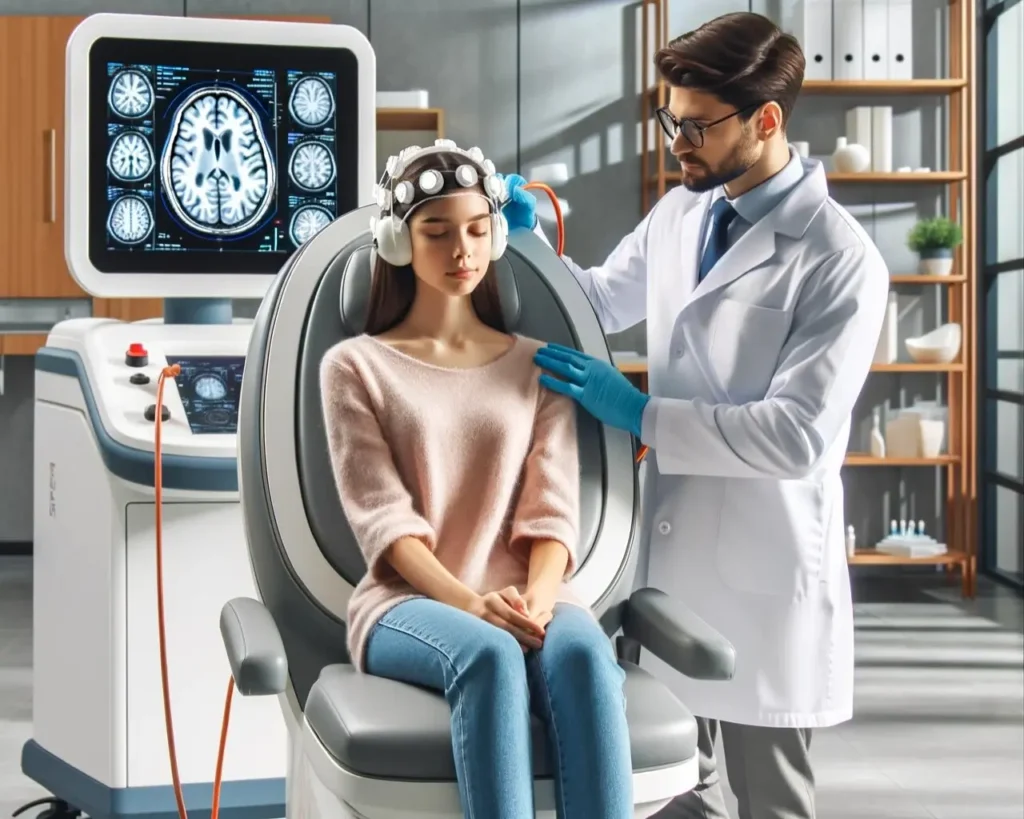What is Deep TMS Therapy? A Comprehensive Guide
Deep Transcranial Magnetic Stimulation (Deep TMS) Therapy is an innovative non-invasive treatment modality used primarily for psychiatric and neurological disorders. It involves the use of magnetic fields to stimulate specific regions of the brain, targeting areas associated with mood regulation, cognition, and behavior.
Unlike traditional TMS, which primarily targets the outer layer of the brain (the cortex), Deep TMS penetrates deeper into the brain structures, allowing for more effective modulation of neural activity. One of the most recent advancements in this field is the development of novel coil designs that enable even deeper stimulation and greater precision in targeting specific brain regions.
These advancements have expanded the potential applications of Deep TMS Therapy and have led to promising outcomes in various psychiatric conditions, including major depressive disorder, obsessive-compulsive disorder, and post-traumatic stress disorder.
Understanding Deep TMS Therapy
Understanding Deep TMS Therapy requires a grasp of its underlying principles and mechanisms. This innovative treatment method utilizes magnetic fields to penetrate deeper into the brain, reaching areas that traditional TMS cannot access.
By targeting specific neural circuits associated with mood regulation, cognition, and behavior, Deep TMS aims to modulate brain activity and restore balance. Unlike electroconvulsive therapy (ECT), Deep TMS is non-invasive and does not require anesthesia, making it a safer and more tolerable option for patients.
Through a series of treatment sessions, Deep TMS has shown promise in alleviating symptoms of various psychiatric disorders, offering new hope to individuals who have not responded to conventional therapies.
- Utilizes magnetic fields for deeper brain penetration
- Targets specific neural circuits for mood regulation and cognition
- Non-invasive alternative to electroconvulsive therapy (ECT)
- Safe and tolerable, without the need for anesthesia
- Effective in alleviating symptoms of psychiatric disorders
How Much is TMS Therapy?
When considering TMS therapy, one of the most common questions that arise is, “How much does it cost?” The cost of TMS therapy, also known as transcranial magnetic stimulation therapy, can vary depending on various factors. These factors include the number of treatments needed, the location of the treatment facility, and any additional services provided.
On average, a single session of TMS therapy typically falls within the range of $300 to $500. However, it’s essential to consult with a healthcare provider or treatment center to get an accurate estimate based on your specific needs and circumstances.
Understanding the cost of TMS therapy involves considering its value in relation to its potential benefits. While the upfront cost may seem significant, it’s essential to recognize that TMS therapy offers a non-invasive and effective alternative for individuals struggling with treatment-resistant psychiatric disorders.
By targeting specific neural circuits in the brain, TMS therapy has shown promise in alleviating symptoms of conditions such as depression, obsessive-compulsive disorder, and post-traumatic stress disorder. Furthermore, when compared to the long-term expenses associated with ongoing medication or traditional therapies, TMS therapy may offer a cost-effective solution for individuals seeking lasting relief from their symptoms.
It’s advisable to explore potential financing options or insurance coverage to help mitigate the financial burden and make TMS therapy more accessible to those in need.
What is TMS Therapy for Anxiety?
TMS therapy for anxiety is a cutting-edge treatment option that targets the underlying neural circuits associated with anxiety disorders. Unlike traditional treatments such as medication or therapy, TMS therapy offers a non-invasive approach to alleviating symptoms and restoring balance in the brain.
By utilizing magnetic fields to stimulate specific regions of the brain, TMS therapy aims to modulate neural activity and disrupt dysfunctional patterns that contribute to anxiety.
This innovative technique has shown promise in providing relief for individuals who have not responded adequately to other treatments or who experience intolerable side effects from medication.
- Magnetic fields penetrate the scalp to stimulate neural circuits associated with anxiety.
- Targeted stimulation helps regulate abnormal brain activity linked to anxiety symptoms.
- Non-invasive nature of TMS therapy reduces the risk of adverse effects commonly associated with medication.
- Treatment sessions are typically conducted over several weeks, with noticeable improvements observed gradually.
- TMS therapy offers a personalized approach, allowing for precise targeting of specific brain regions implicated in anxiety disorders.
How Long Does TMS Therapy Last?
TMS therapy, also known as transcranial magnetic stimulation therapy, typically consists of a series of treatment sessions conducted over several weeks. The specific duration of TMS therapy can vary depending on factors such as the individual’s condition, response to treatment, and treatment protocol recommended by the healthcare provider.
In many cases, patients undergo daily sessions lasting approximately 20 to 30 minutes each, with the total number of sessions ranging from 20 to 30. However, it’s essential to note that the effects of TMS therapy are not instantaneous, and significant improvements may take time to manifest. Many individuals experience lasting benefits from TMS therapy, with studies suggesting that the positive effects can endure for months or even years following the completion of treatment.
Ultimately, the duration of TMS therapy’s efficacy varies from person to person, and ongoing evaluation and follow-up with a healthcare provider are essential to monitor progress and determine the need for maintenance sessions if required.
TMS Therapy Side Effects
TMS (transcranial magnetic stimulation) is a generally safe and well-tolerated treatment for depression. However, like any medical procedure, it can cause some side effects.
Common TMS side effects:
- Headaches (most common)
- Lightheadedness
- Scalp discomfort or pain
- Neck pain
- Tingling or facial twitching
- Sleepiness
- Altered taste
These side effects are usually mild and short-lived. They often improve over the course of treatment as your body adjusts to the stimulation. You may be able to relieve some of these side effects by taking over-the-counter pain medication, such as ibuprofen.
Serious TMS side effects (rare):
- Seizures (risk is less than 1%)
- Hearing problems (usually temporary and caused by the clicking noise during treatment)
- Mania (more common in people with bipolar disorder)
If you experience any serious side effects, it is important to report them to your doctor right away.
Here are some tips to help minimize TMS side effects:
- Let your doctor know about any medications you are taking, as some may interact with TMS.
- Get a good night’s sleep before each treatment.
- Avoid caffeine and alcohol before treatment.
- Eat a light snack before treatment.
- Wear comfortable clothing to your appointments.
If you are considering TMS therapy, it is important to weigh the risks and benefits of treatment. Talk to your doctor about whether TMS is right for you.
Pros and Cons of TMS Therapy
TMS offers a promising alternative for those seeking relief from depression, particularly those who haven’t found success with medication. However, it’s important to consider the time commitment, potential cost, and availability in your area before deciding if it’s the right option for you. Discussing these factors with your doctor can help you make an informed decision.
Pros:
Non-invasive: Unlike medication or electroconvulsive therapy (ECT), TMS doesn’t involve surgery or anesthesia.
Minimal side effects: Compared to medications, TMS has far fewer systemic side effects like fatigue, weight gain, or sexual dysfunction.
Fits into daily routine: Treatments are typically outpatient and relatively quick, allowing you to resume daily activities afterward.
Effective: TMS has shown good response rates for depression, especially for those who haven’t responded well to medications.
No addiction: There’s no risk of dependence or withdrawal symptoms associated with TMS.
No memory issues: Unlike ECT, TMS doesn’t cause memory problems and may even improve cognitive function.
Cons:
Time commitment: Treatment often involves daily or near-daily sessions for several weeks, requiring a significant time commitment.
Availability: TMS therapy may not be widely available in all areas, especially outside major cities.
Cost: While insurance may cover TMS, it can be expensive without coverage.
Limited awareness: Compared to traditional treatments, public awareness of TMS is lower.
Mild discomfort: Some people experience scalp discomfort or headaches during treatment, which usually lessen over time.
Insurance coverage: Insurance companies may have strict criteria for coverage, making approval challenging.
Types of TMS Therapy
There are two main types of TMS therapy currently used: Repetitive Transcranial Magnetic Stimulation (rTMS) and Deep Transcranial Magnetic Stimulation (dTMS).
Repetitive Transcranial Magnetic Stimulation (rTMS)
Repetitive Transcranial Magnetic Stimulation (rTMS) TMS therapy
- This is the most common type of TMS. It uses a magnetic coil to deliver pulses of magnetic fields to a specific area of the brain. The pulses are repeated over time, hence the name “repetitive.”
- rTMS is typically used to treat major depression, but it can also be used to treat other conditions such as anxiety, obsessive-compulsive disorder (OCD), and addiction.
- rTMS works by stimulating or inhibiting the activity of neurons in the brain. The specific effects of rTMS depend on the location of the stimulation and the frequency of the pulses.
Deep Transcranial Magnetic Stimulation (dTMS)
Deep Transcranial Magnetic Stimulation (dTMS) TMS therapy
- This is a newer type of TMS that is designed to reach deeper brain regions than rTMS. It uses a different type of coil that can deliver more focused pulses of magnetic fields.
- dTMS is currently FDA-cleared for the treatment of major depressive disorder and OCD. It is also being studied for use in other conditions such as bipolar disorder and schizophrenia.
- dTMS is thought to work by stimulating brain regions that are involved in mood regulation and emotion processing.
Both rTMS and dTMS are generally safe and well-tolerated treatments. However, they can cause some side effects, such as headaches, scalp discomfort, and lightheadedness. These side effects are usually mild and temporary.
Ending Note
TMS therapy represents a groundbreaking advancement in the field of psychiatry, offering a non-invasive and effective alternative for individuals struggling with treatment-resistant psychiatric disorders. Through the targeted modulation of neural circuits in the brain, TMS therapy has demonstrated remarkable efficacy in alleviating symptoms of depression, anxiety, and other conditions.
While potential side effects exist, they are generally mild and temporary, with serious adverse events being rare. With its promising results and growing body of research supporting its efficacy, TMS therapy continues to provide hope and transformative outcomes for individuals seeking lasting relief from their symptoms.















